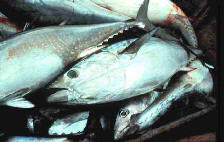|
The Food and Drug Administration is failing in its public health obligation to protect pregnant women and the developing fetus from the toxic effects of mercury, charges the Environmental Working Group. The conservation group warns that fish consumption advisories issued by the agency do not reflect the true danger posed by mercury in fish.
Children who are exposed to mercury in utero may suffer damage to their brains and nervous systems, affecting language, attention and memory.
Internal documents obtained by the Environmental Working Group (EWG) show that focus group meetings organized by the Food and Drug Administration (FDA) supported stronger consumer warnings regarding mercury in fish that those issued by the agency.
In January 2001, the FDA advised that pregnant women and women of child bearing age who may become pregnant avoid eating the four fish species with the highest levels of methyl mercury: shark, swordfish, king mackerel and tile fish.
It concluded that these women could safely eat 12 ounces per week of a variety of other fish, with the emphasis on choosing a variety of different species.
EWG says transcripts of the focus groups reveal that the FDA knows these standards do not protect the fetus, knows that adequate protection would mean adding tuna to the list of restricted fish, and knows that women want as much information as possible, preferably from their doctors.
"The FDA is ignoring the science on mercury and ignoring health information women want and need, while using focus groups as an excuse," said Jane Houlihan, EWG's vice president for research.
"The problem is not FDA using focus groups to determine how it should communicate concerns about mercury in fish to women. The problem is the FDA using focus groups to determine if it should communicate concerns about mercury in fish to women."
Both the U.S. Environmental Protection Agency (EPA) and the National Academy of Sciences (NAS) have recognized that mercury is a substantial public health problem, and recommend much stricter standards for allowable levels of mercury in fish than the FDA.
Swordfish contain some of the highest levels of methyl mercury found in fish.
EWG warns that tuna
which the FDA did not include in its advisory -
can be just as dangerous.
The NAS estimates that every year about
60,000 children are born at "significantly increased risk"
of neurological effects from mercury because of the
contaminated fish their mothers ate. The NAS is also concerned that, aside from the high exposure cases, there is a broad, low level mercury exposure potential that could push a greater percentage of the population into the group of children who struggle to keep up in school or who require remedial education.
A 2001 study by the Centers for Disease Control found that 10 percent of reproductive age American women already carry so much mercury in their blood that if they got pregnant it could pose a threat of neurological damage to the fetus.
The FDA has said that too long a list of fish to avoid
confuses women, and that tuna is safe for pregnant women
and the developing fetus. But in the focus group transcripts,
an FDA scientist admits that FDA's current mercury
"action level" in seafood
does not protect the fetus and also says that
pregnant women need to limit their consumption of tuna
to protect their babies from mercury damage.
The message the FDA gave to the public a few months later, after three private meetings with the tuna and seafood industry, claims that tuna is safe for pregnant women.
In a statement released today, the FDA says it "stands behind the process that led to its current Consumer Advisory on this subject, as well as the science that supports that advisory."
"In reaching its conclusions about methyl mercury in fish, FDA met with a broad range of interested parties, including consumer groups, health professionals, industry and state public health officials," FDA added.
The FDA said it will convene a meeting of its Foods Advisory Committee later this spring to review its consumer advisory for fish and other issues surrounding methyl mercury in commercial seafood.
The focus group transcripts
and other information are available at:
http://www.ewg.org/
The FDA's rationale behind its fish consumption
advisory is available at:
http://www.cfsan.fda.gov/~acrobat/hgadv4.pdf
|


